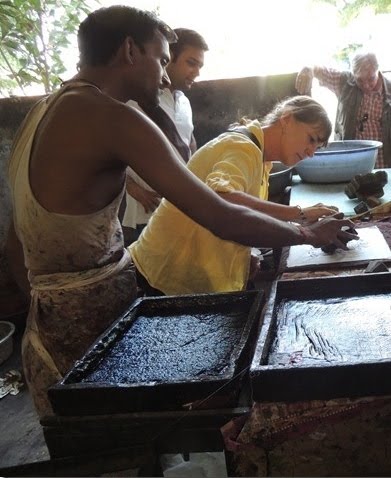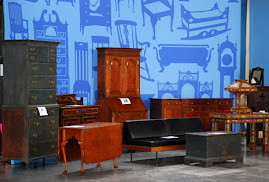 |
| St. Asaph's (Alamance County) Sugar Bowls |
If you like ceramics, have an interest in North Carolina history, or are interested in Moravian and Quaker ceramics, the “Art in Clay” exhibit at MESDA (Museum of Early Southern Decorative Arts) is a must see exhibit. Even if you haven’t previously had an interest in North Carolina redware, this exhibit may pleasantly surprise you.
 |
| Moravian Owl Bottle |
As the culmination of four years of work, research and study, the “Art in Clay” exhibit showcases early North Carolina pottery by presenting examples from some of the premier collections in the country. Ok, so you’ve seen North Carolina early pottery before, so, what’s the big deal about “Art in Clay”? It’s just mud, correct? Redware? Think again. What makes this project and exhibit unique is that the work and research culminating with the exhibit has literally re-written history. And then there’s the fact that this slip decorated redware North Carolina pottery is some of the most beautiful pottery every made! Plain redware it is not.
Due to the combined efforts between ceramic experts, potters, historians, archeologists, and chemists, this pottery from the Piedmont area has unquestionably been identified, dated and attributed, even reattributed in some instances. Moravian pottery has been appreciated for many years due to its originality, beauty and form, but now we know that some of this previously attributed Moravian pottery was actually made by German immigrants who lived and worked in other areas of North Carolina, particularly in the St. Asaph’s area of Alamance County. That’s what has changed history!
 |
| Moravian Aust Shop Sign |
And now the WOW factor kicks in; we are talking about highly decorated slip pottery, dating to the 1770’s into the early 1800’s. And this is not plain, glazed pottery, but beautifully decorated and brightly colored pottery. There are not only plates and mugs, but these really cool lidded storage containers that we now know are sugar bowls, animal forms and flasks. Very little of this pottery is signed, and attributions have been made by researching potters’ kiln sites, inventory records and other early documented sources. By comparing signed or known pieces and using pottery sherds from the archeological digs, dating and geographic attribution of the pottery can be determined. And the Moravian Aust shop sign, a cornerstone piece of the exhibit, is a fabulous one of a kind ceramic bowl style sign that will dazzle you when you walk into the exhibit room.
Work by the early Moravian Potters of Aust and Christ are included in the exhibit…no surprise there. But, works by the German potters from the Loy family living and working in the St. Asaph’s area of Alamance County, and works by Quaker Potters, have also been identified and are included in the exhibit. And these Quaker made pieces are also highly decorated and beautiful. There are about 120 items included, many borrowed from private collectors (some being heirs of the original potters), the Henry Ford Museum, MESDA, Colonial Williamsburg and others. And the items from private collections will be returned to their owners at the end of the exhibit; this two year travelling exhibition is the only way to ever see these privately owned pieces.
 |
| Punch Bowl |
I was fortunate to attend a symposium dedicated to this exhibit, and heard from some of the researchers who worked on this project. There were seminars by ceramics experts, potters, archeologists and historians, all of whom contributed to the research. I participated in special curator led tours of the exhibit, including a tour by Joanna Brown and one by Luke Beckerdite. According to Luke Beckerdite, this collection includes “the best slip decorated colonial ceramics in America.” And coming from a nationally renowned ceramics expert, that’s a pretty good endorsement for North Carolina redware!
And since I am an appraiser, people always ask me about value. Is this old North Carolina pottery valuable? You bet. In 2001, Sotheby’s sold a female figural flask, modeled as a girl standing with a small flower spray clasped before her with her long dress covered in a rich green glaze, and dated 1800 for $31,800 including the buyer’s premium. Now, this is really a one of a kind, very rare item; the other more common pieces are less expensive. In 2010, Brunk Auction sold a simple 7” brown squirrel bottle for $700.00 plus buyer’s premium. And the squirrel had some chips and cracks, and the date was not authenticated! But still, very impressive values!
But this is something you need to see for yourself! We are fortunate that this exhibit is currently at MESDA (Museum of Early Southern Decorative Arts in Winston Salem) and will be there until August 14, 2011. This is a fabulous opportunity to see our North Carolina redware at its best, and to educate yourself about Moravian, St. Asaphs, and Quaker North Carolina pottery. More information on the exhibit can be found at http://www.oldsalem.org/artinclay.html. In a future blog post, we’ll talk a little more about how the slipware pottery was made, but don’t miss the opportunity to see the real stuff. As you walk through the exhibit cases, see if you can tell how the Moravian, St. Asaphs, and Quaker pottery differ from each other. And enjoy them for their beauty; they are truly works of art!
Vicky Nash Shaw,
ISA CAPP Certified Antique and Art Appraiser
919 475-6930


























